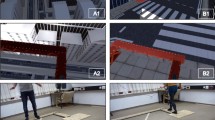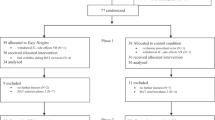Abstract
Recent epidemiological studies indicate that about one-third of the general population suffers from a more or less disabling height intolerance, with a relevant impact on quality of life in many of them. Acrophobia, the most severe form of visual height intolerance, has a life-time prevalence of around 5%. Although it is commonly believed that fear of heights should continuously aggravate with increasing elevation, this issue has not been systematically investigated yet. Here, we examined this topic using immersive virtual reality, an established tool in therapy for fear of heights, that allows to flexibly manipulate height stimuli. In a comprehensive cohort (including insusceptible subjects as well as subjects with height intolerance up to acrophobia) height intolerance severity was graded by an established metric scale (vHISS). Participants were randomly exposed to different virtual elevations using a head-mounted display. Behavioral responses to virtual height exposure were analogous to exposure in vivo. Participants exhibited increased anxiety and musculoskeletal stiffening with enhanced high-frequency body sway, to an extend that corresponded to the individual subjective height intolerance rating. For all behavioral responses, we observed a saturation above a certain altitude. Body sway and musculoskeletal stiffening became maximal at 20 m above ground, whereas anxiety saturated above 40 m. These results suggest that fear of heights is characterized by a nonlinear stimulus–response relationship and a dissociation between visual-height-induced bodily and emotional reactions.



Similar content being viewed by others
Change history
10 June 2019
The original version of this article unfortunately contained a mistake. The surnames of all authors have been interchanged. The corrected author names are given below.
References
Abelson JL, Curtis GC (1989) Cardiac and neuroendocrine responses to exposure therapy in height phobics: desynchrony within the ‘physiological response system’. Behav Res Ther 27:561–567
Adkin AL, Carpenter MG (2018) New Insights on emotional contributions to human postural control. Front Neurol 9:789
Bles W, Kapteyn TS, Brandt T, Arnold F (1980) The mechanism of physiological height vertigo: II. Posturography. Acta Otolaryngol (Stockh) 89:534–540
Brandt T, Arnold F, Bles W, Kapteyn TS (1980) The mechanism of physiological height vertigo: I. Theoretical approach and psychophysics. Acta Otolaryngol (Stockh) 89:513–523
Brandt T, Benson J (2012) Huppert D (2012) What to call “non-phobic” fear of heights. Br J Psychiatry 190:81
Brandt T, Kugler G, Schniepp R, Wuehr M, Huppert D (2015) Acrophobia impairs visual exploration and balance during standing and walking. Ann N Y Acad Sci 1343:37–48
Carpenter MG, Frank JS, Silcher CP, Peysar GW (2001) The influence of postural threat on the control of upright stance. Exp Brain Res 138:210–218
Coelho CM, Waters AM, Hine TJ, Wallis G (2009) The use of virtual reality in acrophobia research and treatment. J Anxiety Disord 23:563–574
Diemer J, Lohkamp N, Muhlberger A, Zwanzger P (2016) Fear and physiological arousal during a virtual height challenge—effects in patients with acrophobia and healthy controls. J Anxiety Disord 37:30–39
Emmelkamp P, Krijn M, Hulsbosch A, De Vries S, Schuemie M, Van der Mast C (2002) Virtual reality treatment versus exposure in vivo: a comparative evaluation in acrophobia. Behav Res Ther 40:509–516
Emmelkamp PM, Felten M (1985) The process of exposure in vivo: cognitive and physiological changes during treatment of acrophobia. Behav Res Ther 23:219–223
Falconer K, Winter D (1985) Quantitative assessment of co-contraction at the ankle joint in walking. Electromyogr Clin Neurophysiol 25:135
Foa EB, Kozak MJ (1986) Emotional processing of fear: exposure to corrective information. Psychol Bull 99:20
Freeman D, Haselton P, Freeman J, Spanlang B, Kishore S, Albery E, Denne M, Brown P, Slater M, Nickless A (2018) Automated psychological therapy using immersive virtual reality for treatment of fear of heights: a single-blind, parallel-group, randomised controlled trial. The Lancet Psychiatry 5:625–632
Horslen BC, Dakin CJ, Inglis JT, Blouin JS, Carpenter MG (2014) Modulation of human vestibular reflexes with increased postural threat. J Physiol 592:3671–3685
Huppert D, Grill E, Brandt T (2017) A new questionnaire for estimating the severity of visual height intolerance and acrophobia by a metric interval scale. Front Neurol 8:211
Huppert D, Grill E, Brandt T (2013) Down on heights? One in three has visual height intolerance. J Neurol 260:597–604
Kugler G, Huppert D, Schneider E, Brandt T (2014) Fear of heights freezes gaze to the horizon. J Vestib Res 24:433–441
Laughton CA, Slavin M, Katdare K, Nolan L, Bean JF, Kerrigan DC, Phillips E, Lipsitz LA, Collins JJ (2003) Aging, muscle activity, and balance control: physiologic changes associated with balance impairment. Gait Posture 18:101–108
LeBeau RT, Glenn D, Liao B, Wittchen HU, Beesdo-Baum K, Ollendick T, Craske MG (2010) Specific phobia: a review of DSM-IV specific phobia and preliminary recommendations for DSM-V. Depress Anxiety 27:148–167
Salassa JR, Zapala DA (2009) Love and fear of heights: the pathophysiology and psychology of height imbalance. Wilderness Environ Med 20:378–382
Schaffler F, Muller M, Huppert D, Brandt T, Tiffe T, Grill E (2014) Consequences of visual height intolerance for quality of life: a qualitative study. Qual Life Res 23:697–705
Simeonov PI, Hsiao H, DotsonM BW, Ammons DE (2005) Height effects in real and virtual environments. Hum Factors 47:430–438
Wuehr M, Brandt T, Schniepp R (2017) Distracting attention in phobic postural vertigo normalizes leg muscle activity and balance. Neurology 88:284–288
Wuehr M, Kugler G, Schniepp R, Eckl M, Pradhan C, Jahn K, Huppert D, Brandt T (2014) Balance control and anti-gravity muscle activity during the experience of fear at heights. Physiol Rep 2:e00232
Acknowledgements
This work was supported by the German Federal Ministry of Education and Research (01EO1401).
Author information
Authors and Affiliations
Contributions
All of the authors have taken part in the preparation of this manuscript, have reviewed the results, and have approved the final version of this manuscript. M.W., D.H., and T.B. conceptualized and designed the study. M.W., K.B., J.D., G.I., D.H., and T.B. collected, analyzed, and interpreted the data. M.W and K.B wrote the paper.
Corresponding author
Ethics declarations
Conflicts of interest
M.W.: no conflicts of interest to be disclosed. K.B.: no conflicts of interest to be disclosed. J.D.: no conflicts of interest to be disclosed. G.I.: no conflicts of interest to be disclosed. D.H.: no conflicts of interest to be disclosed. T.B.: no conflicts of interest to be disclosed.
Ethical standards
TThe study protocol was approved by the Ethics Committee of the University of Munich and was conducted in conformity with the Declaration of Helsinki.
Additional information
This manuscript is part of a supplement sponsored by the German Federal Ministry of Education and Research within the funding initiative for integrated research and treatment centers.
The original version of this article was revised: The surnames of all authors have been interchanged.
Electronic supplementary material
Below is the link to the electronic supplementary material.
Rights and permissions
About this article
Cite this article
Wuehr, M., Breitkopf, K., Decker, J. et al. Fear of heights in virtual reality saturates 20 to 40 m above ground. J Neurol 266 (Suppl 1), 80–87 (2019). https://doi.org/10.1007/s00415-019-09370-5
Received:
Revised:
Accepted:
Published:
Issue Date:
DOI: https://doi.org/10.1007/s00415-019-09370-5




